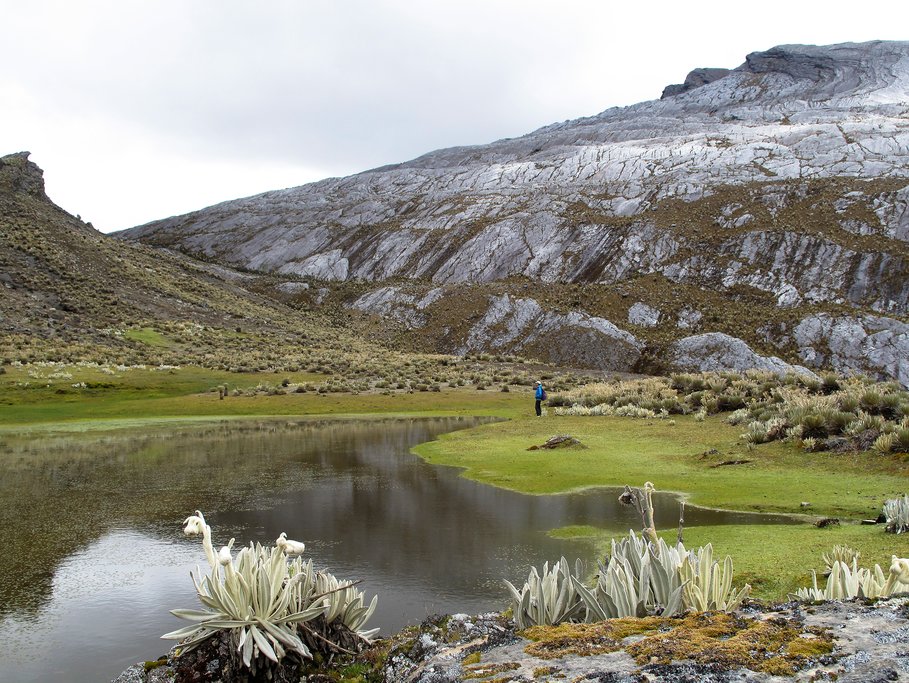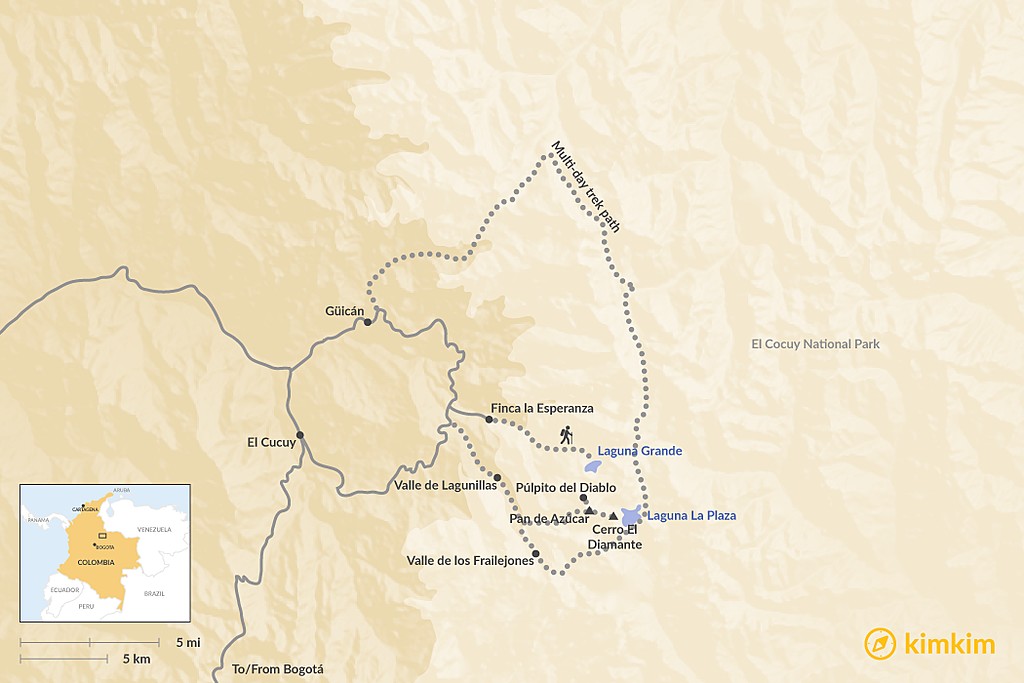*Due to changes in the regulations of the park, trekking is no longer allowed within El Cocuy. We are in the process of updating this article with relevant info about day hiking options. To chat with a specialist about visiting the park, you can submit a trip request Here.
For alternative, lesser-known trekking options in Colombia, we recommend Los Nevados and the Camino Verde treks.
Overview
There are close to 60 national parks in Colombia, each unique in its abundance of natural wonders. They comprise everything from arid deserts, Caribbean coastal parks, and great swaths of the Amazon rainforest. But for inveterate trekkers, there may be no more desirable location in the entire country than Parque Nacional Natural El Cocuy (or Sierra Nevada del Cocuy National Park). This glacial mass is comprised of two parallel north-south mountain ranges 19 miles long and three miles wide, featuring 25 snow-capped peaks. Save for Patagonia, you won't find more rugged and stunning mountainous landscapes in all of South America.
That said, there are considerations here any traveler/trekker must take into account before embarking on a journey through the park. For example, this Andean protected area is a sacred site for Colombia's indigenous Uwa community (for more on Colombia's indigenous peoples, check out this article). The indigenous reserve covers the east side of the park, and is thus closed to tourism; it's prohibited to trek into this area. But not to worry—in this guide, you'll find every practical piece of advice and info to ensure that your Cocuy trek goes off without a hitch.
Planning Your Trip

Parque Nacional El Cocuy is the largest glacial mass north of the equator in South America, so you'll need to take the extreme conditions into account when planning your excursion. Add to this the fact that there's no accommodation on the main trekking circuit (only on the outskirts of the park), and you're looking at having to bring all your own equipment. If you're only doing a day hike, you can get away with little more than cold-weather clothing and hiking boots. However, if you're planning a multi-day trek, you need to pack tents, sleeping bags, cooking gear, water purification tablets, flashlights and other camping necessities.
As far as clothing is concerned, multi-day trekkers need to prepare for all extremes. Pack rainwear as well as cold-weather clothing like weatherproof jackets, gloves, hiking pants, and thermal wear/long underwear. At high altitudes, the glare of the sun can damage your eyes so be sure to pack durable sunglasses. As for equipment, trekking poles, hiking boots, and crampons for snowy terrain are recommended.
When to go
It’s recommended that travelers forgo peak holiday times (from Christmas through the first two weeks of January) because campsites can be crowded. To avoid heavy rains, visit the park during the driest months, from December through April, and July to August. Note that even in the dry seasons you will still be hit with some amount of rain and fog, so don't leave the rainwear at home.
Altitude
The mountains in the park range in altitude from about 16,000 feet to 17,500 feet. To help stave off altitude sickness, arrive in the capital city early enough to acclimate to the higher altitudes (Bogotá itself sits at an altitude of 8,661 feet), and don't rush your ascents. Above all else, be sure to stay hydrated.
Those planning multi-day treks deep into the park can further acclimate by overnighting in one of the last outposts before the park entrance, such as local fincas (country homes) and villagers' cabanas. These typically sit at between 11,000 and 13,000 feet. If you've booked a trek through a company, your itinerary will typically include a stay at one of these locations on your ascent into the park.
Weather
To put it mildly, the weather in the park can be ambivalent. As noted, even though there are dry and wet seasons, you can expect intermittent rains no matter the time of year. The same can be said for fog. This is why, even though hiking trails are clearly marked in Sierra Nevada el Cocuy, we recommend first-timers hire a local guide. They can help you navigate through low visibility, as well as assist with other practicalities. More on this below.
Trekking Cocuy with a guide
Because there are no accommodations in the park, you're going to need to know where to camp and find drinking water. You'll also need to navigate the trekking paths, often in difficult weather conditions. For this reason, we recommend trekking with a local guide. Hiring one can be arranged in the towns outside the park. On top of assisting with practicalities, local guides can provide fascinating information about the flora and fauna of the region as well as local indigenous culture.
Chat with a local specialist who can help organize your trip.
Arriving in Parque Nacional El Cocuy

Logistically speaking, Parque Nacional El Cocuy is easily accessible from Bogotá (for information on cool places to stay, check out our guide to the "Best Boutique Hotels in Bogotá"). Trekkers can arrive at the foot of the park either from the small town of El Cucuy or about six miles north in the town of Güicán. Entry permits to the Parque Nacional El Cocuy are required, but they are easily obtainable in the park offices in either town. Needless to say, most aspects of these towns center around excursions to the park. In El Cocuy, for example, you can find maps and arrange guides, and first-timers without much of a frame of reference will be happy to find a mini model of the park's mountainous terrain on the main plaza.
As for transport, various bus companies leave Bogotá heading north for El Cocuy (11-12 hours, but often takes longer) typically twice a day (one morning bus and one evening bus). However, bus schedules change frequently, so check in advance. After getting to town, plan to arrive at one of the local cabanas that comprise the embarkation point into the park. To do this, you can hike 4-5 hours from the town of El Cocuy to Cabañas Guaicany, at the south entrance to the park, or to Finca la Esperanza, which offers the most direct access to Laguna Grande de la Sierra. For quicker arrival, catch an early morning milk truck (leaving around 6 am) from the main plaza in El Cocuy. Private transport is also available and can be arranged at the plaza.
Cocuy's Top Sights and Activities

Trekking through Cocuy, you're presented with an abundance of natural wonders. Not only do these include the aforementioned snow-capped peaks, but there are majestic cliffs, glacial lakes in brilliant shades of aquamarine, and cascading waterfalls. Here are some of the stunning sights on offer:
Mountains and rock formations
The Pan de Azúcar is a glacial peak sitting at one of the highest points in the park (some 16,732 feet) and hiking it is a feather in the cap for any high-altitude trekker. Just below it is Cerro El Diamante, a large rock formation that gets its name, appropriately, because it's in the shape of a diamond. Trekkers who get lucky with clear weather will discover that upon sunrise the rock flashes brilliant displays of gold, red, yellow, and orange. The Púlpito del Diablo (the Devil's Pulpit) is a stunning rock mass in the shape of an altar.
Some giant glacial peaks that make for great climbing include Toti (15,750 feet) and Ritacuba Blanco, which is the tallest in the park (17,500 feet). Take note: you'll want to visit the glaciers of Cocuy sooner rather than later. A 2013 report by the Colombian Hydrological, Meteorological, and Environmental Studies Institute (IDEAM) predicts that all Colombian glaciers will have melted entirely by 2030.
Lakes
Laguna de la Plaza is generally regarded as the most beautiful lake in the park, notable as much for its glassy blue surface as it is for the rugged nature that surrounds it. Here you'll be treated to striking views of the Pan de Azúcar and Toti in the west. Laguna Grande de la Sierra is another picture-postcard body of water and a great base to trek up to the summit of either the Pan de Azúcar or Toti.
Valleys
The Valle de Lagunillas is the access point for the Pan de Azúcar and the Púlpito del Diablo. here you'll also find the road to the Laguna Grande de la Plaza. It also includes the Valle de los Frailejones, which features seemingly endless amounts of frailejón (Espeletia) plants, which are ubiquitous in the park.
Birding
There are some 2000 species of birds endemic to Colombia, and Cocuy is a great place to see some. Even though the park is off the birding circuit, you can be sure to spot some lovely highland páramo species (by Laguna Grande is a good vantage point), including the glossy flowerpiercer, black-tailed trainbearer, and Andean siskin. Also, this area of Colombian páramo is the backyard of the country's national bird, the Andean condor.
Crafting Your Ideal Trek

El Cocuy is ideal for two different types of trekking. As mentioned above, you can make day excursions to the park; however, serious trekkers will want to plan for about a week of actual trekking in order to experience the park's full majesty. You should also allow more time for transfers to/from Bogotá as well as your stay in the capital and in the towns at the base of the park.
Day trekking
This can be accomplished from any of the cabanas that sit on the outskirts of the park and requires no camping gear. that said, many of the cabanas and fincas, on top of renting rooms and serving meals, will allow you to camp on their grounds for a small fee. There are hikes to Laguna de la Plaza, which take about 10 hours roundtrip. There are also day hikes to Púlpito del Diablo, which take about six hours roundtrip.
Multi-day trek (6-7 days)
This itinerary allows you to experience all the highlights of the park (be aware that it requires a good level of physical fitness). On this circuit, you'll visit the Valle de Lagunillas, Púlpito del Diablo, Pan de Azúcar, Laguna de la Plaza, Laguna Grande, the glacier peak of el Toti, Cerro El Diamante, and the Valle de los Frailejones. Be prepared to spend 5-7 hours per day hiking.


